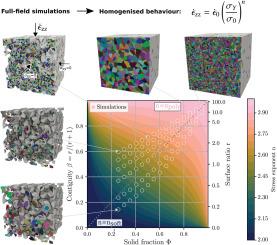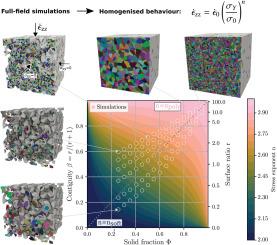多晶的粘塑性对孔隙率和孔晶尺寸比的敏感性
IF 9.3
1区 材料科学
Q1 MATERIALS SCIENCE, MULTIDISCIPLINARY
引用次数: 0
摘要
多孔多晶是由孔洞和烧结晶体组成。了解它们的粘塑性行为对于预测制造材料的力学性能或地质成分的演变至关重要。它们的粘塑性直观地取决于固体基体的形状以及如何将其划分为单个晶体。以前的研究主要集中在低孔隙度或极端孔晶尺寸比的极限情况下。在本研究中,我们采用三维多孔微观结构的数值全场模拟,结合晶体塑性模型,探讨几何结构和晶体结构对多晶粘塑性的影响。我们使用冰和它的多孔形式,雪,作为模型材料。研究结果表明,均匀应变率ε (ε)符合应力σσ的幂律,即ε (ε) =σσ0 (ε) =σσ0 (σ0), σ0 (σ0)为参考应力,nn为应力指数。值得注意的是,我们发现参考应力仅由几何结构决定,而应力指数受几何结构和晶体结构的影响。具体来说,应力指数是由相邻晶体引起的几何挫折控制的,这调节了不同滑移系统中的位错蠕变。通过将孔晶尺寸比定义为晶体边界和自由表面之间的面积比,我们为理解这些相互作用提供了一个连贯的框架。该研究阐明了不同孔隙率下粘塑性行为的转变,避免了对额外机制的需要,并为多孔多晶粘塑性提供了有价值的见解。本文章由计算机程序翻译,如有差异,请以英文原文为准。


Sensitivity of the viscoplasticity of polycrystals to porosity and pore-to-crystal size ratio
Porous polycrystals are composed of pores and sintered crystals. Understanding their viscoplastic behaviour is crucial for predicting the mechanical performance of manufactured materials or the evolution of geological components. Their viscoplasticity intuitively depends on the shape of the solid matrix and how it is divided into individual crystals. Previous studies have primarily focused on limiting cases with low porosities or extreme pore-to-crystal size ratios. In this study, we use numerical full-field simulations on three-dimensional porous microstructures, combined with a crystal plasticity model, to explore how polycrystal viscoplasticity is affected by both geometric and crystalline structures. We use ice and its porous form, snow, as model materials. Our findings demonstrate that the homogenised strain rate fits a power law of stress as s−1 with the reference stress and the stress exponent. Notably, we show that the reference stress is determined solely by the geometric structure, while the stress exponent is influenced by both the geometric and crystalline structures. Specifically, the stress exponent is governed by the geometric frustration of the crystals caused by their neighbours, which modulates dislocation creep across different slip systems. By defining the pore-to-crystal size ratio as the area ratio between the crystal boundary and the free surface, we provide a coherent framework for understanding these interactions. This study clarifies the transitions in viscoplastic behaviour with varying porosity, avoiding the need for additional mechanisms and offering valuable insights into porous polycrystal viscoplasticity.
求助全文
通过发布文献求助,成功后即可免费获取论文全文。
去求助
来源期刊

Acta Materialia
工程技术-材料科学:综合
CiteScore
16.10
自引率
8.50%
发文量
801
审稿时长
53 days
期刊介绍:
Acta Materialia serves as a platform for publishing full-length, original papers and commissioned overviews that contribute to a profound understanding of the correlation between the processing, structure, and properties of inorganic materials. The journal seeks papers with high impact potential or those that significantly propel the field forward. The scope includes the atomic and molecular arrangements, chemical and electronic structures, and microstructure of materials, focusing on their mechanical or functional behavior across all length scales, including nanostructures.
 求助内容:
求助内容: 应助结果提醒方式:
应助结果提醒方式:


